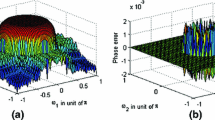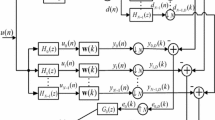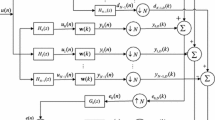Abstract
A novel method of linear approximation of a matrix is proposed for designing the linear-phase and non-linear-phase extrapolated impulse response (EIR) filters. There are zero-valued and one-valued coefficients in the scale vectors of the proposed EIR filters. These zero-valued coefficients do not require multipliers or adders, and these one-valued coefficients do not require multipliers, in the filter implementation. Additionally, the optimal design of the EIR filters in the mini-max sense and the least-square sense by the iterative gradient searching (IGS) technique is investigated. In implementing the IGS technique, the original EIR filter, the principal component analysis based EIR filter and the proposed EIR filter are set as the initial solutions, separately. If the proposed EIR filter is set as the initial solution, the IGS technique can synthesize the prototype finite impulse response (FIR) filter satisfactorily, with the lowest hardware implementation complexity. Further, experimental comparison of the proposed EIR method with the two most popular non-EIR low-complexity FIR filter design methods also indicates some superiority of the proposed EIR method. Finally, the proposed method of linear approximation of a matrix may also be useful in other areas of signal processing.










Similar content being viewed by others
References
J. Adams, A. Willson Jr, A new approach to FIR digital filters with fewer multipliers and reduced sensitivity. IEEE Trans. Circuits Syst. CAS–30, 277–283 (1983)
J. Adams, A. Willson Jr, Some efficient digital prefilter structures. IEEE Trans. Circuits Syst. CAS–31(3), 260–266 (1984)
T. Baran, D. Wei, A.V. Oppenheim, Linear programming algorithms for sparse filter design. IEEE Trans. Signal Process 58(3), 1605–1617 (2010)
M.R. Bateman, B. Liu, An approach to programmable CTD filters using coefficients 0, +1, and -1. IEEE Trans. Circuits Syst. CAS–27(6), 451–456 (1980)
G.F. Boudreaux, T.W. Parks, Thinning digital filters: A piecewise-exponential approximation approach. IEEE Trans. Acoust. Speech Signal Process. ASSP–31(1), 105–113 (1983)
Y.F. Cao, K. Wang, W.J. Pei, Y.J. Liu, Y.F. Zhang, Design of high order extrapolated impulse response FIR filters with signed power of two coefficients. Circuits Syst. Signal Process. 30(5), 963–985 (2011)
T.N. Davidson, Enriching the art of FIR filter design via convex optimization. IEEE Signal Process. Mag. 27(3), 89–101 (2010)
M. Grant, S. Boyd, Matlab software for convex programming. http://cvxr.com/cvx/download. Accessed 15 Dec 2014
R.J. Hartnett, G.F. Boudreaux-Bartels, On the use of cyclotomic polynomial prefilters for efficient FIR filter design. IEEE Trans. Signal Process. 41(5), 1766–1779 (1993)
A.M. Jiang, H.K. Kwan, Y.P. Zhu, X.F. Liu, Minimax design of sparse FIR digital filters. Proc. IEEE ICASSP 2012, 3497–3500 (2012)
A.M. Jiang, H.K. Kwan, Y.P. Zhu, Peak-error-constrained sparse FIR filter design using iterative SOCP. IEEE Trans. Signal Process. 60(8), 4035–4044 (2012)
F.K.H. Lee, P.J. McLane, Design of nonuniformly-spaced tapped-delay-line equalizers for sparse multipath channels. Proc. IEEE GLOBECOM 2001, 1336–1343 (2001)
Y.C. Lim, Frequency-response masking approach for the synthesis of sharp linear phase digital filters. IEEE Trans. Circuits Syst. CAS–33(4), 357–364 (1986)
Y.C. Lim, B. Liu, Extrapolated impulse response FIR filter. IEEE Trans. Circuits Syst. 37(12), 1548–1551 (1990)
Y.C. Lim, R. Yang, D. Li, J. Song, Signed power-of-two term allocation scheme for the design of digital filters. IEEE Trans. Circuits Syst. II 46(5), 577–584 (1999)
Y.C. Lim, Y.J. Yu, Synthesis of very sharp Hilbert transformer using the frequency-response masking technique. IEEE Trans. Signal Process. 53(7), 2595–2597 (2005)
J.H. McClellan, T.W. Parks, A personal history of the Parks-McClellan algorithm. IEEE Signal Process. Mag. 22(2), 82–86 (2005)
Y. Neuvo, C.Y. Dong, S.K. Mitra, Interpolated finite impulse response filters. IEEE Trans. Acoust. Speech Signal Process. ASSP–32(3), 563–570 (1984)
W.J. Oh, Y.H. Lee, Design of efficient FIR filters with cyclotomic polynomial prefilters using mixed integer linear programming. IEEE Signal Process. Lett. 3(8), 239–241 (1996)
D. Wei, A.V. Oppenheim, A branch-and-bound algorithm for quadratically constrained sparse filter design. IEEE Trans. Signal Process. 61(4), 1006–1018 (2013)
H. Wang, L. Zhao, W.J. Pei, J.K. Zuo, Q.Y. Wang, M.H. Xin, An iterative technique for optimally designing extrapolated impulse response filter in the mini-max sense. IEICE Trans. Fundam. Electron. Commun. Comput. Sci. E96–A(10), 2029–2033 (2013)
H. Wang, L. Zhao, H.X. Wang, S.L. Fang, P.X. Liu, X.M. Du, An optimal design of the extrapolated impulse response filter with analytical solutions. Signal Process. 92(7), 1665–1672 (2012)
J. Yli-Kaakinen, T. Saramaki, An efficient algorithm for the optimization of FIR filters synthesized using the multistage frequency response masking approach. Circuits Syst. Signal Process. 30(1), 157–183 (2011)
Y.J. Yu, G.H. Zhao, K.L. Teo, Y.C. Lim, Optimization of extrapolated impulse response filters using semi-infinite programming. In: Proceedings of First International Symposium on Control, Communications and Signal Processing, pp. 397–400 (2004)
Y.J. Yu, D. Shi, Y.C. Lim, Design of extrapolated impulse response filter with residual compensation in subexpression space. IEEE Trans. Circuits Syst. I 56(12), 2621–2633 (2009)
Y.J. Yu, K.L. Teo, Y.C. Lim, G.H. Zhao, Extrapolated impulse response filter and its application in the synthesis of digital filters using the frequency-response masking technique. Signal Process. 85(3), 581–590 (2005)
L.H. Zhou, W.J. Pei, P.C. Xi, Z.Y. He, Extrapolated impulse filter using coefficient-auto-correlation matrix decomposition. Signal Process. 88(7), 1762–1774 (2008)
Acknowledgments
The authors would like to thank the anonymous referees and Haixian Wang for constructive recommendations.This work was supported by the Natural Science Foundation of ZhejiangProvince under Grants Nos. LY12F01006 and LY14F010010, the Scientific Research Foundation of Department of Education of Zhejiang Province under Grants No. Y201329723, and the Natural Science Foundation of China under Grant Nos. 61375028, 61273266 and 61301219.
Author information
Authors and Affiliations
Corresponding author
Rights and permissions
About this article
Cite this article
Wang, H., Cheng, X., Song, P. et al. An Extrapolated Impulse Response Filter Design with Sparse Coefficients Based on a Novel Linear Approximation of Matrix. Circuits Syst Signal Process 34, 2335–2361 (2015). https://doi.org/10.1007/s00034-014-9955-6
Received:
Revised:
Accepted:
Published:
Issue Date:
DOI: https://doi.org/10.1007/s00034-014-9955-6




